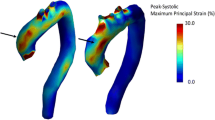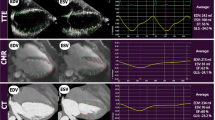Abstract
Accurate assessment of aortic extensibility is a requisite first step for elucidating the pathophysiology of an ascending thoracic aortic aneurysm (ATAA). This study aimed to develop a framework for the in vivo evaluation of the full-field distribution of the aortic wall strain by imaging analysis of electrocardiographic- (ECG) gated thoracic data of 34 patients with ATAA. Seven healthy controls (i.e., non-aneurysmal aorta) from patients who underwent ECG-gated CT angiography for coronary artery diseases were included for comparison. To evaluate the systolic function, ECG-gated computed tomography (CT) angiography was used to generate patient-specific geometric meshes of the ascending aorta, and then to estimate both the displacement and strain fields using a mathematical algorithm. Results evidenced stiff behavior for the aneurysmal aorta compared with that of the healthy ascending aorta of the controls, with patients over 55 years of age displaying significantly lower extensibility. Moreover, the patient risk as quantified by the ratio of in vivo strain to the ruptured one increased significantly with increased systolic blood pressure, older age, and higher pressure-strain modulus. Statistical analysis also indicated that an increased pressure-strain modulus is a risk factor for ATAAs with bicuspid aortic valve, suggesting a different mechanism of failure in these patients. The approach here proposed for the in vivo evaluation of the aortic wall strain is simple and fast, with promising applicability in routine clinical imaging, and could be used to develop a rupture potential criterion on the basis of the aortic aneurysm extensibility.






Similar content being viewed by others
References
Dandel, M., H. Lehmkuhl, C. Knosalla, N. Suramelashvili, and R. Hetzer. Strain and strain rate imaging by echocardiography—basic concepts and clinical applicability. Curr Cardiol Rev 5:133–148, 2009.
de Beaufort, H. W., F. J. Nauta, M. Conti, E. Cellitti, C. Trentin, E. Faggiano, G. H. van Bogerijen, C. A. Figueroa, F. L. Moll, J. A. van Herwaarden, F. Auricchio, and S. Trimarchi. Extensibility and distensibility of the thoracic aorta in patients with aneurysm. Eur J Vasc Endovasc Surg 53:199–205, 2017.
Duprey, A., O. Trabelsi, M. Vola, J. P. Favre, and S. Avril. Biaxial rupture properties of ascending thoracic aortic aneurysms. Acta Biomater 42:273–285, 2016.
Elefteriades, J. A., and E. A. Farkas. Thoracic aortic aneurysm clinically pertinent controversies and uncertainties. J Am Coll Cardiol 55:841–857, 2010.
Girdauskas, E., M. Rouman, K. Disha, B. Fey, G. Dubslaff, B. Theis, I. Petersen, M. Gutberlet, M. A. Borger, and T. Kuntze. Functional aortic root parameters and expression of aortopathy in bicuspid versus tricuspid aortic valve stenosis. J Am Coll Cardiol 67:1786–1796, 2016.
Haraldsson, H., M. Hope, G. Acevedo-Bolton, E. Tseng, X. Zhong, F. H. Epstein, L. Ge, and D. Saloner. Feasibility of asymmetric stretch assessment in the ascending aortic wall with DENSE cardiovascular magnetic resonance. J Cardiovasc Magn Reson 16:6, 2014.
Hill, M. R., X. Duan, G. A. Gibson, S. Watkins, and A. M. Robertson. A theoretical and non-destructive experimental approach for direct inclusion of measured collagen orientation and recruitment into mechanical models of the artery wall. J Biomech 45:762–771, 2012.
Isselbacher, E. M. Thoracic and abdominal aortic aneurysms. Circulation 111:816–828, 2005.
Kim, K. H., J. C. Park, H. J. Yoon, N. S. Yoon, Y. J. Hong, H. W. Park, J. H. Kim, Y. Ahn, M. H. Jeong, J. G. Cho, and J. C. Kang. Usefulness of aortic strain analysis by velocity vector imaging as a new echocardiographic measure of arterial stiffness. J Am Soc Echocardiogr 22:1382–1388, 2009.
Koullias, G., R. Modak, M. Tranquilli, D. P. Korkolis, P. Barash, and J. A. Elefteriades. Mechanical deterioration underlies malignant behavior of aneurysmal human ascending aorta. J Thorac Cardiovasc Surg 130:677–683, 2005.
Krishnan, K., L. Ge, H. Haraldsson, M. D. Hope, D. A. Saloner, J. M. Guccione, and E. E. Tseng. Ascending thoracic aortic aneurysm wall stress analysis using patient-specific finite element modeling of in vivo magnetic resonance imaging. Interact Cardiovasc Thorac Surg 21:471–480, 2015.
Martin, C., W. Sun, T. Pham, and J. Elefteriades. Predictive biomechanical analysis of ascending aortic aneurysm rupture potential. Acta Biomater 9:9392–9400, 2013.
Martin, C., W. Sun, C. Primiano, R. McKay, and J. Elefteriades. Age-dependent ascending aorta mechanics assessed through multiphase CT. Ann Biomed Eng 41:2565–2574, 2013.
Morrison, T. M., G. Choi, C. K. Zarins, and C. A. Taylor. Circumferential and longitudinal cyclic strain of the human thoracic aorta: age-related changes. J Vasc Surg 49:1029–1036, 2009.
Nathan, D. P., C. Xu, J. H. Gorman, III, R. M. Fairman, J. E. Bavaria, R. C. Gorman, K. B. Chandran, and B. M. Jackson. Pathogenesis of acute aortic dissection: a finite element stress analysis. Ann Thorac Surg 91:458–463, 2011.
Nathan, D. P., C. Xu, T. Plappert, B. Desjardins, J. H. Gorman, 3rd, J. E. Bavaria, R. C. Gorman, K. B. Chandran, and B. M. Jackson. Increased ascending aortic wall stress in patients with bicuspid aortic valves. Ann Thorac Surg 92:1384–1389, 2011.
Oishi, Y., Y. Mizuguchi, H. Miyoshi, A. Iuchi, N. Nagase, and T. Oki. A novel approach to assess aortic stiffness related to changes in aging using a two-dimensional strain imaging. Echocardiography 25:941–945, 2008.
O’Rourke, M. F., J. A. Staessen, C. Vlachopoulos, D. Duprez, and G. E. Plante. Clinical applications of arterial stiffness; definitions and reference values. Am J Hypertens 15:426–444, 2002.
Pape, L. A., T. T. Tsai, E. M. Isselbacher, J. K. Oh, P. T. O’Gara, A. Evangelista, R. Fattori, G. Meinhardt, S. Trimarchi, E. Bossone, T. Suzuki, J. V. Cooper, J. B. Froehlich, C. A. Nienaber, and K. A. Eagle. Aortic diameter ≥5.5 cm is not a good predictor of type A aortic dissection—observations from the international registry of acute aortic dissection (IRAD). Circulation 116:1120–1127, 2007.
Pasta, S., G. Gentile, G. M. Raffa, D. Bellavia, G. Chiarello, R. Liotta, A. Luca, C. Scardulla, and M. Pilato. In Silico shear and intramural stresses are linked to aortic valve morphology in dilated ascending aorta. Eur J Vasc Endovasc Surg 54:254–263, 2017.
Schaefer, B. M., M. B. Lewin, K. K. Stout, E. Gill, A. Prueitt, P. H. Byers, and C. M. Otto. The bicuspid aortic valve: an integrated phenotypic classification of leaflet morphology and aortic root shape. Heart 94:1634–1638, 2008.
Teixeira, R., N. Moreira, R. Baptista, A. Barbosa, R. Martins, G. Castro, and L. Providencia. Circumferential ascending aortic strain and aortic stenosis. Eur Heart J Cardiovasc Imaging 14:631–641, 2013.
Trabelsi, O., A. Duprey, J. P. Favre, and S. Avril. Predictive models with patient specific material properties for the biomechanical behavior of ascending thoracic aneurysms. Ann Biomed Eng 44:84–98, 2016.
Verma, S., and S. C. Siu. Aortic dilatation in patients with bicuspid aortic valve. N Engl J Med 370:1920–1929, 2014.
Wittek, A., K. Karatolios, C. P. Fritzen, J. Bereiter-Hahn, B. Schieffer, R. Moosdorf, S. Vogt, and C. Blase. Cyclic three-dimensional wall motion of the human ascending and abdominal aorta characterized by time-resolved three-dimensional ultrasound speckle tracking. Biomech Model Mechanobiol 15:1375–1388, 2016.
Youssefi, P., A. Gomez, T. He, L. Anderson, N. Bunce, R. Sharma, C. A. Figueroa, and M. Jahangiri. Patient-specific computational fluid dynamics-assessment of aortic hemodynamics in a spectrum of aortic valve pathologies. J Thorac Cardiovasc Surg 153:8–20, 2017.
Yuda, S., R. Kaneko, A. Muranaka, A. Hashimoto, K. Tsuchihashi, T. Miura, N. Watanabe, and K. Shimamoto. Quantitative measurement of circumferential carotid arterial strain by two-dimensional speckle tracking imaging in healthy subjects. Echocardiography 28:899–906, 2011.
Acknowledgments
This work was supported by a “Ricerca Finalizzata” grant from the Italian Ministry of Health (GR-2011-02348129) to Salvatore Pasta, and by the Fondazione Ri.MED for research on aneurysm biomechanics.
Author information
Authors and Affiliations
Corresponding author
Additional information
Associate Editor Lakshmi Prasad Dasi oversaw the review of this article.
Rights and permissions
About this article
Cite this article
Pasta, S., Agnese, V., Di Giuseppe, M. et al. In Vivo Strain Analysis of Dilated Ascending Thoracic Aorta by ECG-Gated CT Angiographic Imaging. Ann Biomed Eng 45, 2911–2920 (2017). https://doi.org/10.1007/s10439-017-1915-4
Received:
Accepted:
Published:
Issue Date:
DOI: https://doi.org/10.1007/s10439-017-1915-4




